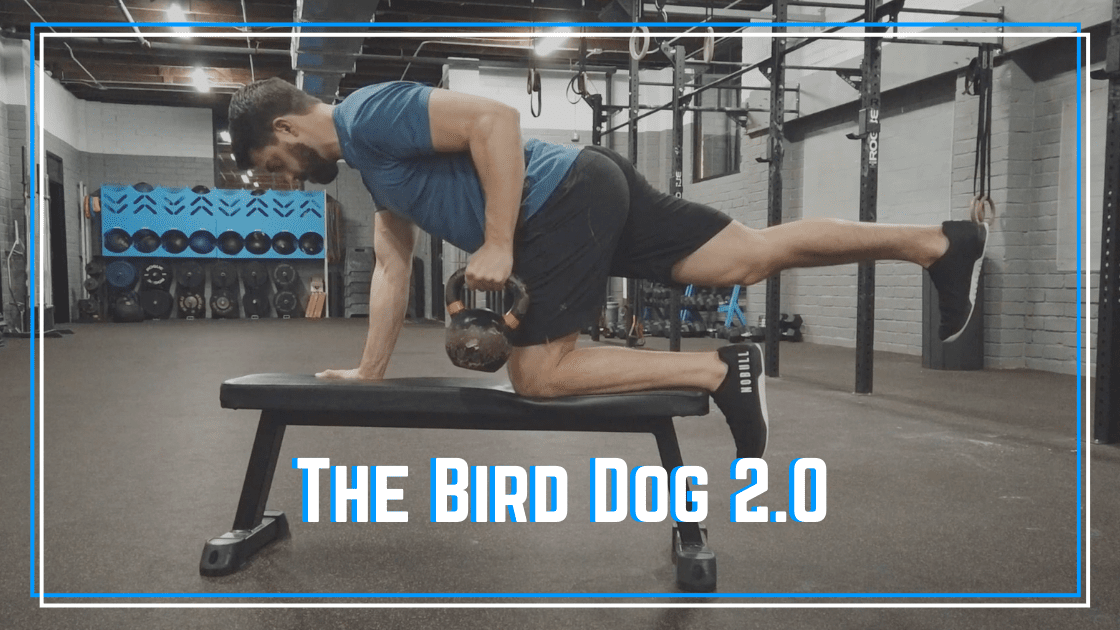The bird dog, traditionally programmed for people who either are doing some low back rehab or trying to work on some spinal stability, can be one tough exercise. Rotary stability, glute activation, anterior core control, scapular stability, and lower trap development. Very few athletes, coaches, and clinicians understand how valuable the bird dog can be beyond simply a rehab exercise. When programmed appropriately, the bird dog can become one awesome strength & performance exercise!
While I love the bird dog, lets be real here, the basic bird dog is not that hard and most people can crush it after a few sessions of practice and are not going to improve their performance that much after that point.
In contrast, these variations below will provide a real challenge for athletes and boost to your strength game.
Bird Dog Variations for Strength
BAND RESISTED BIRD DOG EXERCISE
The easiest way to increase the demand is by adding some band resistance. I chose to start with this option as it’s the easiest change and can be added to most of the following as well. With the band we really increase the demand for hip extension and shoulder flexion.
SHORT BENCH BIRD DOG
Want to increase the demand for rotational control? Give this bad boy a shot. By reducing the base of support we increase the demand on your ability to maintain your balance over it.
KNEE HOVER BIRD DOG
At any point that we reduce the number of points in contact with the ground (knees in this case) we will increase the demand for stability. Your goal here is to maintain your hip and shoulder relation through this, making for one intense quad burn!
BEAR CRAWL BIRD DOG EXERCISE
If your head over heels about crawling like me, you’ll love this one. The bear crawl is essentially the knee hover bird dog starting position, so we have essentially created a moving bird dog. This variation puts a much higher demand on shoulder stability than any of the previous.
SHOULDER REACTIVITY BIRD DOG
On the topic of increasing shoulder stability, with this variation we change to an unstable surface and increase the demand placed upon the rotator cuff, scapular stabilizers, and the wrist musculature.
BIRD DOG SQUARES
A great variation from Dr. Stuart McGill where we are now incorporating a more isometric contraction at the end range position and challenging the musculature to coordinate motion there. While not necessarily as “grueling” as some of the other variations above, it is great for testing how well an athlete can create extremity motion in multiple planes while maintaining their spinal position.
BIRD DOG ROWS
I got this variation from Dr. Joel Seedman and have become obsessed with it. While it has only slowly been getting introduced into my client’s programs, it has been in a good portion of my training sessions to some extent. When you combine my love of bird dog variations with my obsession with rowing, you get an incredible love child.
BENCH BIRD DOG EXERCISE WITH LATERAL BAND PULL
The bird dog is primarily a forward back movement while resisting rotation. When we add in the lateral band pull we incorporate a lateral component to become a triplanar movement. Going on the bench reduces the width of your base, putting a greater demand on the hips to resist the lateral pull.
BIRD DOG PULL IN
Let me be clear, this takes a bit of rigging up but man is it worth it. Generally the bird dog is a lower-body extension and upper body flexion drill; in this version we flip it around by having two bands for you to pull in.
ROTATION BIRD DOG
This variation came to me one day while working with an athlete doing some Turkish get-ups and I was explaining the concept of reaching and kicking. In this we challenge you to control your trunk and rotate on a pivoted foot and hand.
Let me finish off with a bit of clarity for all of these:
Make sure that positioning takes precedence for them all, maintain your trunk position, and focus on control over load. Each of these is an advanced variation, meaning you should have mastered the normal bird dog before progressing to each of these. It is not normal to have pain with any of them and if you happen to, seek a good practitioner out to get it sorted out.
Move well, lift heavy, stay health,
The Strength Therapist






